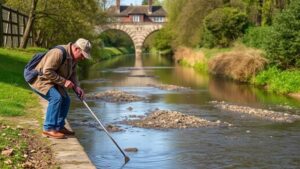Rational Reconstruction of Trade Routes for Relic Recovery
Rational Reconstruction of Trade Routes for Relic Recovery
The rational reconstruction of trade routes plays a crucial role in the preservation and recovery of archaeological relics. As societies evolve, their trade networks reflect a complex interplay of socio-economic factors, geopolitics, and cultural exchanges. Understanding these routes not only aids in the detection and recovery of lost relics but also informs us about the civilizational advancements of the past. This article delves into the methodologies for reconstructing these trade routes, examines real-world applications, and highlights case studies that exemplify successful relic recovery.
The Importance of Trade Route Reconstruction
Trade routes have historically served as arteries of commerce, connecting different civilizations and facilitating the exchange of goods, ideas, and culture. By reconstructing these pathways, researchers can pinpoint potential sites of archaeological interest. The importance lies in various aspects:
- Historical Context: Understanding trade interactions sheds light on the economic relationships and power dynamics of ancient societies.
- Geographical Insights: Trade routes often reveal patterns in settlement, resource distribution, and migration.
- Cultural Exchange: Routes can show the diffusion of technology, art, and beliefs across regions.
Methodologies for Rational Reconstruction
Rational reconstruction of trade routes encompasses several methodologies combining historical texts, archaeological findings, and modern technology. Here are key approaches:
1. Historical Text Analysis
Scholars analyze historical documents such as merchant logs, travel accounts, and administrative records. These texts often provide primary evidence of trade practices, routes, and commodities exchanged. A notable example is the Silk Road, extensively documented in Chinese and Persian records, which offers insight into the goods traded and the travelers who journeyed across it.
2. GIS and Spatial Analysis
Geographic Information Systems (GIS) enable researchers to visualize and analyze spatial data related to ancient trade routes. By mapping geographical features, climate conditions, and archaeological sites, scholars can reconstruct likely pathways. For example, a study using GIS to analyze the Roman trade network provided new insights into the main trade arteries connecting Rome to provincial cities.
3. Archaeological Evidence
Excavation of trade hubs, warehouses, and ports provides tangible evidence of goods traded and the logistics of transportation. For example, excavations at the ancient port city of Ostia, Italy, revealed trade artifacts that corroborate historical accounts of the Mediterranean trade network.
Real-World Applications
The methodologies for rational reconstruction have been pivotal in several real-world scenarios involving relic recovery. e applications not only aid in the recovery of artifacts but also enhance our understanding of ancient economies.
Case Study: The Road of the Amazons
The Road of the Amazons, an ancient trade route in South America, was reconstructed using a blend of historical records and modern geological surveys. Researchers employed satellite imaging to identify altered landscapes indicative of ancient pathways. This reconstruction enabled archaeologists to locate previously undiscovered sites, resulting in a significant relic recovery operation that yielded artifacts dating back to pre-Columbian times.
Case Study: The Spice Route
The historical Spice Route connecting East and West has been a focal point for economic historians. By employing desert geological analysis and studying ancient maritime charts, researchers were able to identify key stopover points for traders. This led to successful excavations of shipwrecks and coastal settlements, recovering valuable relics such as spice jars and trade coins, which illustrate the wealth and intricacies of ancient trade.
Challenges in Relic Recovery
Despite advances in trade route reconstruction, several challenges persist:
- Environmental Erosion: Natural disasters and climate change can jeopardize archaeological sites, making recovery difficult.
- Political Instability: Many trade routes traverse regions with ongoing conflicts, creating hazardous conditions for research.
- Illegal Artifact Trade: The illicit market for antiquities complicates recovery efforts as artifacts can easily be lost to history.
Conclusion and Actionable Takeaways
The rational reconstruction of trade routes is imperative for enhancing our understanding of historical societies and facilitating the recovery of their relics. By employing a combination of historical analysis, GIS technology, and archaeological studies, researchers can uncover significant insights into ancient trade dynamics. successful case studies provide a blueprint for future archaeological endeavors.
In summary, further investment in research methodologies and collaborative efforts between historians, archaeologists, and modern technologists will bolster efforts in relic recovery. Also, raising public awareness about the importance of preserving cultural heritage will be crucial in preventing the loss of invaluable artifacts in the future.

